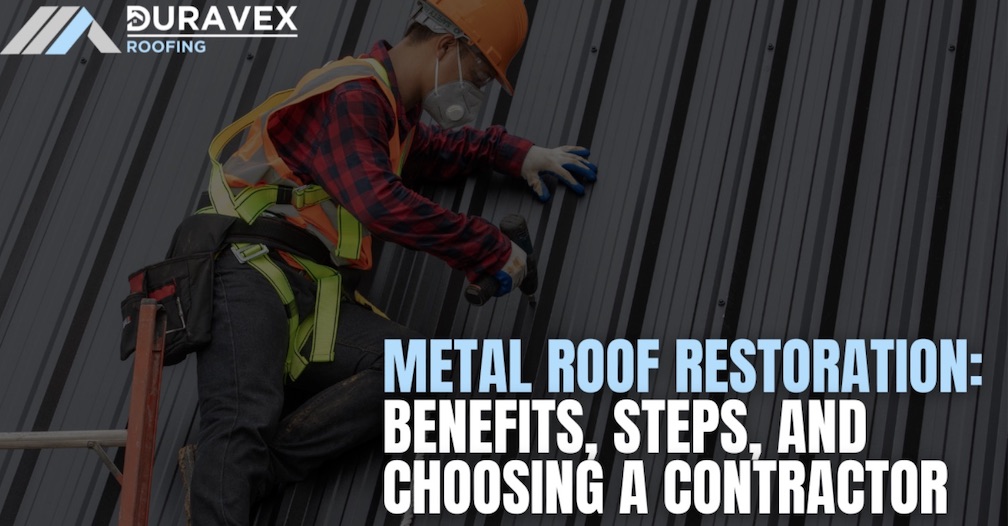Metal Roof Restoration: Benefits, Steps, And Choosing A Contractor

Metal Roof Restoration
Metal rooftops are known for their toughness and life span. However, they are susceptible to wear and tear over time, just like any other roofing material. The cost-effective alternative to roof replacement, which can be costly and time-consuming, is Metal Roof Restoration. We'll talk about the advantages of restoring metal roofs and the steps involved in the process in this blog.
Benefits of Metal Roof Restoration:
Cost-effective: Rooftop reclamation is a more savvy arrangement contrasted with a full rooftop substitution. Repairing any damage and applying a protective coating to the roof to extend its lifespan are part of the restoration process.
Energy-efficient: Restoring a metal roof can make your building use less energy. Using reflective coatings during the restoration process can help lower energy costs by lowering the amount of heat absorbed by the roof.
Further developed appearance: The process of restoration can make your roof look better. Over the long haul, metal rooftops can become stained or foster rust spots. The roof's color and appearance can be restored through the restoration process.
a longer lifespan: Your roof's lifespan can be extended by up to 15 years with metal roof restoration. Weather, UV rays, and other environmental factors can all cause damage, which can be mitigated by the protective coatings used in the restoration process.
Steps Involved In Metal Roof Restoration:
1. Inspection
The most vital phase in metal rooftop reclamation is to review the rooftop for any harm. The material worker for hire will outwardly investigate the rooftop for any indications of harm, like rust, erosion, and breaks. They will likewise actually look at the flashings, drains, and downspouts for any harm or indications of mileage.
The contractor will also look at the roof's overall condition during the inspection. They'll check for dents, loose panels, and other signs of use. Additionally, the contractor will search for any structural damage that could compromise the roof's integrity.
2. Preparation
The roof's preparation for restoration is the next step. Cleaning the roof to get rid of any dirt, debris, or rust is part of this. Pressure washing will be used to remove any loose coatings or paint from the roof. Additionally, any rust or corrosion on the roof surface will be removed by the contractor.
The planning stage is basic to the outcome of the rebuilding system. The coating may not adhere properly, resulting in premature failure, if the roof is not properly cleaned and prepared.
3. Fixes
When the rooftop is cleaned and ready, any harm to the rooftop will be fixed. This may entail repairing any leaks, replacing any damaged flashings, or replacing any damaged panels. Before beginning the restoration process, the contractor will check the structure of the roof.
Assuming that there is any primary harm to the rooftop, the worker for hire might have to make fixes prior to continuing with the reclamation cycle. This could mean strengthening the structure of the roof or replacing damaged panels.
4. Primers
The roof will be primed after the repairs are finished. The primer enhances the coating's adhesion and provides additional resistance to rust and corrosion. Additionally, the primer contributes to the prevention of leaks by sealing any roof gaps or cracks.
There are a variety of primers to choose from, including epoxy primers and rust inhibitor primers. Based on your specific requirements, the roofing contractor will select the best primer for your roof.
5. Coating
Applying a protective coating to the roof is the final step in the restoration process. Acrylic, silicone, and polyurethane coatings are among the many available coatings. Based on your specific requirements, the roofing contractor will select the best coating for your roof.
Over the roof's surface, the coating provides a layer of protection against UV rays, the weather, and other environmental factors. The covering additionally assists with further developing the energy proficiency of the structure by reflecting daylight and decreasing intensity ingestion.
You can apply the coating with a spray, brush, or roller. The number of coats applied will be determined by the roof's condition and the type of coating.
Choosing A Metal Roof Contractor
Choosing a Contractor for Metal Roof Restoration When selecting a contractor for your project of metal roof restoration, it is essential to select a reputable contractor with experience in this field. Find a contractor who has a track record of successful projects and contented clients. Before hiring them for the job, check their credentials and ask for references.
The contractor should provide a comprehensive estimate of the project's cost and timeline, as well as a description of the materials and methods they will employ. They ought to likewise have the option to address any inquiries you might have about the cycle and give proposals to the best strategy in view of your particular requirements.

